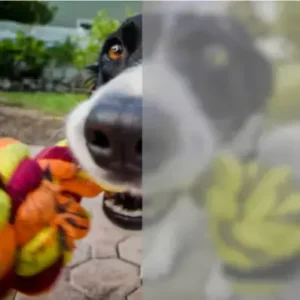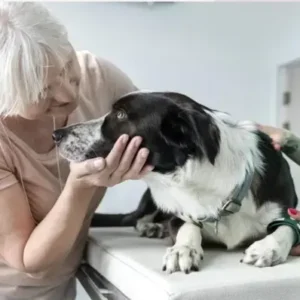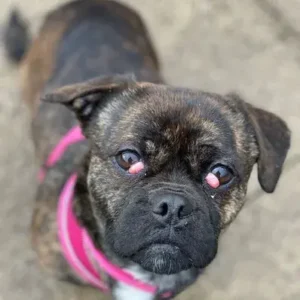Conjunctivitis (Pink Eye) in Dogs
Conjunctivitis, or “pink eye,” is the inflammation of the tissue covering the front of the eye and inner eyelids.
- Symptoms include redness, swelling, and discharge, which can vary in color from clear to yellow or green.
- Causes range from bacterial or viral infections to allergies and irritants.
- Treatment typically involves antibiotic or anti-inflammatory eye drops, and identifying and addressing underlying causes, such as allergies, can help prevent recurrence.
Dry Eye (Keratoconjunctivitis Sicca)
Dry Eye, or Keratoconjunctivitis Sicca (KCS), is a condition where a dog’s eyes don’t produce enough tears to keep the eyes moist.
- Symptoms include red eyes, thick discharge, and frequent blinking.
- Causes can include immune-mediated diseases, trauma, or certain medications.
- Treatment often involves artificial tears or medication to stimulate tear production, along with regular vet check-ups to monitor the condition.
Cataracts in Dogs
Cataracts in dogs cause cloudiness in the lens of the eye which focuses light, leading to impaired vision.
- Symptoms may appear as a cloudy, bluish-gray eye, and affected dogs may bump into objects or have difficulty seeing.
- Causes include genetics, diabetes, and aging.
- Treatment typically involves surgical removal of the cataract. Early detection is essential to prevent worsening vision loss.
Glaucoma in Dogs
Glaucoma is a serious condition characterized by increased pressure within the eye, which can lead to vision loss if untreated.
- Symptoms include redness, eye enlargement, cloudiness, and pain (indicated by pawing at the eye or keeping the eye closed).
- Causes include genetics, eye injuries, conditions like cataracts, and age-related changes that affect fluid drainage in the eye.
- Treatment is crucial and may involve medications to reduce pressure or surgical options for more severe cases.
Cherry Eye in Dogs
Cherry Eye occurs when a gland in a dog’s third eyelid swells and protrudes, forming a red, fleshy mass in the eye’s corner.
- Symptoms of Cherry Eye in dogs include a red, swollen mass in the corner of the eye, along with excessive tearing and discomfort.
- Causes are often genetic, and some breeds, like Bulldogs and Beagles, are more prone to this condition.
- Treatment may involve surgical correction to reposition the gland and restore normal eye function.
Corneal Ulcers in Dogs
Entropion and Ectropion are conditions where a dog’s eyelids roll inward or outward, respectively. Entropion causes the eyelashes to irritate the eye, while Ectropion can expose the eye to dust and debris.
- Symptoms include excessive tearing, squinting, and redness.
- Causes are typically genetic, with breeds like Shar Peis and Cocker Spaniels more prone to these issues.
- Treatment often involves surgical correction to prevent further irritation and maintain eye health.
Retinal Issues in Dogs
Retinal issues in dogs occur when the retina, which is essential for vision, becomes damaged or deteriorates. Conditions like retinal degeneration can lead to vision loss or blindness.
- Symptoms include night blindness, difficulty navigating in low light, dilated pupils, and abnormal eye movements.
- Causes can include genetic conditions, such as progressive retinal atrophy (PRA), age-related degeneration, or underlying health issues like diabetes.
- Treatment focuses on managing symptoms and slowing degeneration, often involving eye drops or ointments to reduce inflammation and support eye health.
Lazy Eye in dogs
Lazy Eye in dogs occurs when one eye does not develop normal vision. This condition can result from genetics, injury, or underlying issues.
- Symptoms include misalignment of the eyes, reduced visual attention, or clumsiness.
- Causes include genetics, eye injuries, misalignment (strabismus), cataracts, and untreated retinal issues that affect normal vision development.
- Treatment depends on the cause and may include corrective surgery, lenses, or monitoring. Early detection is key for effective management and ensuring your dog’s vision remains healthy.
Dry Eyes in Dogs
Dry Eyes in dogs occur when the eyes do not produce enough tears, leading to discomfort and irritation.
- Symptoms include redness, squinting, excessive blinking, and thick, stringy discharge.
- Causes can be genetic, immune-mediated disorders, or destruction of tear glands.
- Treatment often includes artificial tears, medications to stimulate tear production, and regular vet check-ups to monitor the condition.
Watery Eyes in Dogs
Watery Eyes in dogs occur when there is excessive tear production, often in response to irritation or infection.
- Symptoms include constant tearing, watery discharge, and sometimes swelling around the eyes.
- Causes include allergies, conjunctivitis, or foreign objects in the eye.
- Treatment focuses on addressing the underlying cause, which may involve medications, cleaning, or removal of irritants.
Bulging Eyes in Dogs
Bulging Eyes in dogs, also known as exophthalmos, occur when the eyeball protrudes from the eye socket.
- Symptoms include visible bulging of the eyes, squinting, and difficulty closing the eyelids.
- Causes can include trauma, infections, or tumors behind the eye.
- Treatment may involve medications, surgery, or treating the underlying condition causing the bulging.
Swollen Eyes in Dogs
Swollen Eyes in dogs occur when the tissues around the eye become inflamed or puffed up.
- Symptoms include puffiness, redness, and excessive tearing.
- Causes can include allergies, infections, or eye injuries.
- Treatment depends on the cause and may involve antihistamines, antibiotics, or topical treatments to reduce swelling and relieve discomfort.
Glassy Eyes in Dogs
Glassy Eyes in dogs occur when the eyes appear dull or lack focus, often indicating discomfort or illness.
- Symptoms include lack of responsiveness to light, excessive tearing, and squinting.
- Causes can include pain, fever, or eye infections.
- Treatment depends on the underlying cause and may involve medications or more advanced care for specific conditions like infections or systemic illnesses.
Cloudy Eyes in Dogs
Cloudy Eyes in dogs refer to a milky or grayish appearance of the eye, often indicating a vision issue.
- Symptoms include blurry vision, bumping into objects, and a dull appearance in the eye.
- Causes can include cataracts, glaucoma, or aging changes in the eye.
- Treatment may involve surgery for cataracts, medication for glaucoma, or regular monitoring depending on the cause.
Goopy Eyes in Dogs
Goopy Eyes in dogs refer to thick, sticky eye discharge that accumulates around the eyes.
- Symptoms include crusty buildup, watery discharge, and frequent blinking.
- Causes can include conjunctivitis, infections, or allergies.
- Treatment typically involves cleaning the affected area, using antibiotics or anti-inflammatory medications, and addressing any underlying infections or allergies.
Third Eyelid Visible in Dogs
A visible third eyelid in dogs occurs when the nictitating membrane (also known as the third eyelid) protrudes over the eye, often giving the appearance of a pink or white mass.
- Symptoms include the visible third eyelid, squinting, or excessive tearing.
- Causes can include conjunctivitis, eye infections, or conditions like cherry eye or dryness.
- Treatment depends on the underlying cause and may involve antibiotics, anti-inflammatory medications, or surgical correction, such as for cherry eye.
Preventing Dog Eye Problems
While not all eye diseases are preventable, these steps can help:
- Regular cleaning and grooming to prevent debris buildup.
- Protection during outdoor activities with goggles if necessary.
- A balanced diet rich in vitamins A, C, and E for eye health.
- Routine vet visits for eye exams to catch issues early.
When to See a Veterinarian
Certain symptoms of eyes require immediate veterinary attention, including:
- Severe redness, swelling, or discharge.
- Sudden vision loss or disorientation.
- Rapid blinking or holding the eye shut. Documenting symptoms and timing can help your vet in diagnosing and treating the condition effectively.
Breeds Prone to Eye Issues
Certain dog breeds are more susceptible to eye problems, including:
- Pugs and Bulldog (often prone to cherry eye and dry eye)
- Cocker Spaniel (prone to glaucoma and cataracts)
- Chinese Shar-Pei (susceptible to entropion) Knowing your dog’s breed-specific risks can help you watch for signs early and take preventive measures.
- Boston Terrier, congenital strabismus is common and usually doesn’t require treatment.
- Basset Hound, Bloodhound, Retriever, Bulldog (prone to ectropion)
- Labrador Retrievers, Saint Bernard, Shar-Pei, Rottweilers(prone to entropion)
- Cairn Terrier (prone to cataracts and glaucoma)
- Collie (susceptible to Collie eye anomaly, which can impair vision)








